MENU
STIDS 2011 Home
About--
Topic list
Program Committee
Venue & Local info
Registration
Sponsors
Program--
Keynote Speakers
Tutorial
Agenda & Papers
Proceedings
Call for Papers
Important dates
Submission details
Download CFP
Attendees
C4I
Home

SEMANTIC
TECHNOLOGY FOR
INTELLIGENCE,
DEFENSE, AND
SECURITY
Tuesday, November 15th
| Tutorial | ||
| 08:30 - 09:00 | Registration | |
| 09:00 - 10:20 | Part 1 - Syntax, Semantics, Ontology Spectrum, and Semantic Models presenter: Leo Obrst presentation |
|
| 10:20 - 10:40 | Break | |
| 10:40 - 12:00 | Part 2 - Logic, Ontologies, Semantic Web presenter: Leo Obrst |
|
| 12:00 - 13:30 | Lunch | |
| 13:30 - 14:20 | Part 3 - Probability and Logic: Bayesian Semantics presenter: Kathryn Laskey presentation |
|
| 14:20 - 14:50 | Break | |
| 14:50 - 16:10 | Part 4 - Probabilistic Ontologies, PR-OWL presenter: Paulo Costa presentation models UnBBayes References |
Wednesday, November 16th
| 08:00 - 09:00 | Registration and Breakfast | ||
| 09:00 - 09:10 | Initial remarks | ||
| 09:10 - 09:30 | Welcome from the Director of the C4I Center | ||
| 09:30 - 10:30 | Keynote Address | ||
|
Jim Hendler Semantic Web: Reviewing and Renewing the Vision presentation |
|||
| 10:30 - 11:00 | Break | ||
| 11:00 - 12:00 | Research Session - Chair: Leo Obrst | ||
| 11:00 - 11:30 |
PR-OWL 2 Case Study: A Maritime Domain Probabilistic Ontology paper presentation |
Kathryn Laskey, et al C4I Center George Mason University |
|
|
Abstract
Probabilistic ontologies incorporate uncertain and incomplete information into domain ontologies, allowing
uncertainty in attributes of and relationships among domain entities to be represented in a consistent and
coherent manner. The probabilistic ontology language PR-OWL provides OWL constructs for representing multi-entity
Bayesian network (MEBN) theories. Although compatibility with OWL was a major design goal of PR-OWL, the initial
version fell short in several important respects. These shortcomings are addressed by the latest version, PR-OWL 2.
This paper provides an overview of the new features of PR-OWL 2 and presents a case study of a probabilistic
ontology in the maritime domain. The case study describes the process of constructing a PR-OWL 2 ontology using
an existing OWL ontology as a starting point. |
|||
| 11:30 - 12:00 |
COA modeling with probabilistic ontologies paper presentation |
Henrique C. Marques, José M. P. Oliveira and Paulo C. G. Costa Inst. Technológico de Aeronáutica, Brazil C4I Center, George Mason University |
|
|
Abstract
Planning during complex endeavors is a daunting task in many aspects. A key one being the representation of
shared intent, an open research topic that involves expressing a common picture among different planning systems
with distinct languages, and sometimes disparate problem solving methodologies. The common approach is to use a
translator between the order/request message and the planning system, which doesnŐt convey all the elements that
are necessary to support the planning task. The present research proposes to address this issue by the use of a
semantic layer as an interface among different planning systems, which not only improves interoperability but
also provides support for pruning the search space before the information is sent to the planning system. The
layer is based on a probabilistic ontology, which provides shared intent description as well as formalization
of the operational domain and of the planning problem, including a principled representation of the involved
uncertainty. The proposed scheme supports previous analysis of the search space in order to send to the planning
system a concise set of tasks that will contribute to reach the desired end state. |
|||
| 12:00 - 13:30 | Lunch | ||
| 13:30 - 14:15 | Invited Speaker | ||
|
Gheorghe Tecuci Development of Cognitive Assistants by Subject Matter Experts presentation  We present the current status and applications of an evolving theory
We present the current status and applications of an evolving theoryand technology for the development of cognitive assistants by subject matter experts who are not knowledge engineers or computer scientists. This approach, called Disciple, synergistically integrates mixed- initiative problem solving,evidence-based reasoning, teaching, and multistrategy learning, enabling direct teaching of a learning agent by a subject matter expert. The Disciple approach has been successfully employed to develop cognitive assistants in a wide variety of domains, including intelligence analysis, center of gravity determination, course of action critiquing, emergency response planning, and PhD advisor assessment. It is envisioned that this approach will enable typical computer users to develop their own personal cognitive assistants for the semantic web. |
|||
| 14:15 - 15:10 | Research Session - Chair: Barry Smith | ||
| 14:15 - 14:45 |
Integration of Intelligence Data through Semantic Enhancement paper presentation |
David Salmen, Tatiana Malyuta, Alan Hansen, Shaun Cronen and Barry Smith University at Buffalo |
|
|
Abstract
We describe a strategy for data integration that is based on the idea of a unified representation of data
and data- semantics. The strategy promises a number of benefits: it can be applied incrementally; it creates
minimal barriers to the incorporation of new data into the integrated system; it preserves the existing data
and data-semantics in their original form (thus provenance information is retained, and no heavy pre-processing
is required); and it embraces the full spectrum of data sources, types, models, and modalities (including text,
images, audio, signals). The result of applying this strategy to a given body of data is an evolving syntactically
integrated DataSpace that supports the application of a variety of integration and analytic processes to diverse
data contents. Semantic integration is performed through a light-weight and flexible process of what we call
Semantic Enhancement. It leverages richness of the structured contents of the DataSpace without adding storage
and processing burdens to what, in the intelligence domain, will be an already storage- and processing-heavy
starting point. And it works not by changing the data to which the strategy is applied, but rather by adding
an extra semantic layer to this data. We sketch how the Semantic Enhancement approach can be applied consistently
and in cumulative fashion to new data and data- models that enter the DataSpace. |
|||
| 14:45 - 15:10 |
An Ontology-based Adaptive Reporting Tool
paper presentation |
Christian Mårtenson, Andreas Horndahl and Ziaul Kabir Swedish Defense Research Agency The Royal Institute of Technology |
|
|
Abstract
Intelligence gathering by human observers is important for acquiring indirect and non-physical information.
The drawback is that it is often delivered as free text which is not well-suited for further exploitation
through automatic processing. In this paper we present a concept for structured human reporting based on an
ontology-driven adaptive user-interface. The concept lays the foundation for the implementation of a possibly
hand-held in-field reporting system, which can adapt to the context of the reporting situation as well as
to possible information needs of other agents in the intelligence system. |
|||
| 15:10 - 15:40 | Break | ||
| 15:40 - 17:30 | Research Session - Chair: Sandra Thompson | ||
| 15:40 - 16:10 |
A Framework for Ontology-Supported Intelligent Geospatial Feature Discovery Services paper presentation |
Liping Di, Peng Yue, Peisheng Zhao, Wenli Yang, Weiguo Han George Mason University |
|
|
Abstract
Geospatial feature discovery from remote sensing imageries is widely used in national defense and security
communities. Existing methods in the geospatial image mining and feature extraction focus on the manual or
automated processing of images to detect individual elementary features, such as building and highway. Such
elementary features donŐt tell much semantic information about the features. Compound geospatial features
such as Weapons of Mass Destruction (WMD) proliferation facilities are spatially composed of elementary
features (e.g., buildings for hosting fuel concentration machines, cooling ponds, and transportation railways).
The identity and much semantic information of a compound geospatial feature can be derived from the spatial
relationship among the elementary elements. In this paper, we propose a flexible service framework for discovering
compound geospatial features using an ontology-supported approach. The ontology for facilities helps find compound
features that contain the specified spatial relationships among constituent features. The framework uses Web
services for elementary feature extraction or access of existing elementary features, identifies facilities
based on semantic descriptions of elementary feature constituents and their spatial relationships, and composes
workflow-based service chains for automatic feature discovery. |
|||
| 16:10 - 16:40 |
CHAMPION: Intelligent Hierarchical Reasoning Agents for Enhanced Decision Support paper presentation |
Ryan Hohimer, Frank Greitzer, Christine Noonan, Jana Strasburg Pacific NW National Laboratory |
|
|
Abstract
We describe the design and development of an advanced reasoning framework employing semantic technologies,
organized within a hierarchy of computational reasoning agents that interpret domain specific information.
The CHAMPION reasoning framework is designed based on an inspirational metaphor of the pattern recognition
functions performed by the human neocortex. The framework represents a new computational modeling approach
that derives invariant knowledge representations through memory- prediction belief propagation processes that
are driven by formal ontological language specification and semantic technologies. The CHAMPION framework
shows promise for enhancing complex decision making in diverse problem domains including cyber security,
nonproliferation and energy consumption analysis. |
|||
| 16:40 - 17:05 |
Ontology-based Software for Generating Scenarios for Characterizing Search for Nuclear Materials paper presentation |
Richard Ward, Alex Sorokine, Bob Schlicher, Michael Wright and Kara Kruse Oak Ridge National Laboratory |
|
|
Abstract
A software environment was created in which ontologies are used to significantly expand the number
and variety of scenarios for special nuclear materials (SNM) detection based on a set of simple generalized
initial descriptions. A framework was built that combined advanced reasoning from ontologies with geographical
and other data sources to generate a much larger list of specific detailed descriptions from a simple initial
set of user-input variables. This presentation shows how basing the scenario generation on a process of
inferencing from multiple ontologies, including a new SNM Detection Ontology (DO) combined with data extraction
from geodatabases, provided the desired significant variability of scenarios for testing search algorithms,
including unique combinations of variables not previously expected. The various components of the software
environment and the resulting scenarios generated will be discussed. |
|||
| 17:05 - 17:30 |
Use of Ontology to Facilitate the Creation of Synthetic Imagery of Industrial Facilities paper presentation |
Paul Pope and Randy Roberts Los Alamos National Laboratory Lawrence Livermore Natl Lab |
|
|
Abstract
Algorithms which perform auto-annotation of remotely sensed imagery need to undergo verification and validation (V&V)
such that the end user can make a fitness-for- use judgment regarding their particular application and can be assured
of a high level of confidence in achieving success. Synthesizing these data is one means of obtaining the imagery
required to conduct benchmark testing. This paper presents a system to create benchmark imagery of industrial facilities
for conducting V&V of auto-annotation algorithms. The method proposes to leverage an ontology of industrial facilities
to capture domain knowledge regarding both the industrial process flow as well as the objects required to support
the industrial process at a particular production level. |
|||
| 17:30 | Social Event | ||
Thursday, November 17th
| 08:30 - 09:30 | Breakfast | ||
| 09:30 - 10:15 | Invited Speaker | ||
|
Dennis E. Wisnosky Realizing Efficiency & Interoperability: SOA & Semantic Technology in the Business Mission Area (BMA), U.S. DoD presentation video 1 video 2  The US Department of Defense (DoD) is leading the transformation
The US Department of Defense (DoD) is leading the transformation of architecture-driven business systems/services development and deployment. Key principles to achieving DoD business transformation are: capabilities delivered as services within a SOA, enterprise architecture standards, domain ontologies,and the utilization of semantic technology to support data interoperability and business intelligence. Mr. Wisnosky will discuss the Department's strategy, and give a high-level overview of the work being done towards realizing efficiency and interoperability within the DoD BMA. (Bio) |
|||
| 10:15 - 10:45 | Break | ||
| 10:45 - 11:45 | Parallel Research Sessions | ||
| Room 3 - Chair: Kathryn Laskey | |||
| 10:45 - 11:15 |
Semantic Policy Enforcement and Reconciliation for Information Exchange in XMPP paper presentation |
Won Ng, Oleg Simakoff, Brian Ulicny, Jakub Moskal and Mieczyslaw Kokar VIStology, Inc and Northeastern University |
|
|
Abstract
Extensible Messaging and Presence Protocol (XMPP) is a popular open-standard protocol for instant messaging
(IM) widely used in military and commercial applications. In military contexts, as in commercial settings,
it is often necessary to regulate who may communicate with whom and how. The distributed nature of XMPP makes
centralized information exchange policy enforcement impossible, however. We report on a technology we have
developed, called PolVISor, in which we express information exchange policies in a natural language-like
formalism (SBVR SE), automatically translate these policies into an executable rule language (BaseVISor rule
language) and enforce and reconcile disparate policies among XMPP servers, each with its own policies, using
semantic technologies. |
|||
| 11:15 - 11:45 |
Speech acts and Tokens for Access Control and Provenance Tracking paper presentation |
Fabian Neuhaus & Bill Andersen NCOR |
|
|
Abstract
In many domains ontology-based technologies will be only successful if they support access control and
provenance tracking. A key feature of our approach is the explicit representation of speech acts as well
as sentence tokens that are used to encode propositions in IT systems. These are used to define SupportedBy,
a kind of entailment relationship between sentence tokens and propositions. Queries of a user are phrased
in terms of the SupportedBy relationship and augmented by user-dependent security constraints. |
|||
| Room 4 - Chair: David Boyd | |||
| 10:45 - 11:15 |
Computational Theory and Cognitive Assistant for Intelligence Analysis paper presentation |
Gheorghe Tecuci, Dorin Marcu, Mihai Boicu, David Schum and Katherine Russell Learning Agents Center, George Mason University |
|
|
Abstract
This paper presents elements of a computational theory of intelligence analysis and its implementation
into a cognitive assistant. Following the framework of the scientific method, the theory provides computational
models for essential analysis tasks: evidence marshaling for hypotheses generation, hypotheses-driven evidence
collection, and hypotheses testing through multi-INT fusion. Many of these models have been implemented into
a web-based cognitive assistant which not only assists an analyst in coping with the astonishing complexity
of intelligence analysis, but it also learns from their joint analysis experience. |
|||
| 11:15 - 11:45 |
SCUBA: An Agent-Based Ontology Creation and Alignment Method for Socio-Cultural Modeling paper presentation |
Donald Kretz, William Phillips and Bruce Peoples Raytheon Company |
|
|
Abstract
An otherwise promising business, political, or military strategy can be crippled by an incomplete understanding
of the social-cultural factors that define and influence a region. Such omissions are sometimes due to oversight,
but often stem from a fundamental lack of understanding of how to model such difficult and unfamiliar concepts.
The information required to generate useful contextual models is typically available but vast, and manual
interpretation of detailed text is time-consuming, highly subjective, and requires specialized skills. The SCUBA
project achieved a balanced human-computer modeling paradigm to 1) automate the creation of social and cultural
ontologies from selected source materials using previously-developed tools, 2) apply a variety of nominal,
semantic, structural, and statistical matching techniques to align multiple ontologies using an agent- based
multimodel, and 3) evaluate the effectiveness of the generation and alignment processes using precision,
recall, and various other measures of effectiveness. Preliminary results of our initial agent-based experiments
were promising - by applying ensembles of multiple matching techniques, we achieved significant improvements in
alignment F-scores and other measures of performance while dramatically reducing the amount of time required
to manually produce coordinated, useful domain models. |
|||
| 11:45 - 13:30 | Lunch | ||
| 13:30 - 14:45 | Panel - Moderator: David Boyd | ||
|
Semantic Enhancement for Data Retrieval and Integration in the Cloud panelists info |
STIDS 2010 Panelists: Bill Andersen (Highfleet, Inc.) Kathy Laskey (George Mason University) Tanya Malyuta (Data Tactics Corp.) Barry Smith (NCOR, University at Buffalo) |
||
| 14:45 - 15:15 | Break | ||
| 15:15 - 15:45 | Research Session - Chair: Mike Dean | ||
| 15:15 - 15:45 |
Finding and Explaining Similarities in Linked Data paper presentation |
Catherine Olsson, Plamen Petrov, Jeff Sherman and Andrew Perez-Lopez Raytheon BBN Technologies |
|
|
Abstract
Today's computer users and system designers face increasingly vast amounts of data, yet lack good tools to find
pertinent information within those datasets. Linked data technologies add invaluable structure to data, but
challenges remain in helping users understand and exploit that structure. One important question users might
ask about their data is "What entities are similar to this one, and why?" or "How similar are these two entities
to one another, and why?". Our work focuses on using the semantic content of linked data not only to facilitate
the process of finding similar entities, but also to produce automatically-generated and human-understandable
explanations of what makes those entities similar. In this paper, we formulate a definition of an "explanation"
of similarity, we describe a system that can produce such explanations efficiently, and we present a methodology
to allow the user to tailor how "obvious" or "obscure" the provided explanations are. |
|||
| 15:45 - 16:00 | Epilogue: Future of STIDS - Paulo Costa | ||

 (
(